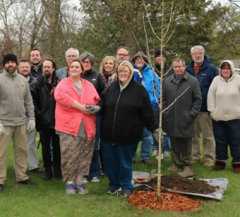Community Forestry Challenge Grant Brings Opportunities to local South Dakota communities
Guest post from the South Dakota Department of Agriculture: Division of Resource Conservation & Forestry, Community Forestry Program in coordination with the Western Urban and Community Forestry Network's #HealthyTreesHealthyLives social media campaign. Explore the hashtag #HealthyTreesHealthyLives on social media to learn more.

Did you know? An urban forest provides similar benefits to other types of forests in many regards - the trees filter out pollutants from water before it reaches underground water systems, it creates oxygen and sequester carbon, and provides a source of biomass that can be used for many products that we use daily.
In a 2014 research study titled Trees Improve Human Health and Save Lives, David Nowak gathers information on the health benefits of trees with the help of the USDA Forest Service and Davey Institute scientists. Modeling of local environmental data revealed that trees removed 17.4 million metric tons of air pollution across the contiguous United States in 2010, with human health effects valued at 6.8 billion dollars1. The human health effects included the avoidance of more than 850 incidences of human mortality and 670,000 incidences of acute respiratory symptoms1 .
Urban forests are experienced everyday by all members of the community and South Dakota recognizes the importance that urban forests can have on community health. The South Dakota Department of Agriculture: Division of Resource Conservation & Forestry has been striving to help communities build their urban forests through the Community Forestry Challenge Grant program since 1991. A portion of the division's annual allocation of Urban and Community Forestry Assistance funds from the USDA Forest Service is awarded to communities in the form of Challenge grants in hopes that this will showcase the major benefits of maintaining urban forests.
These Challenge grants are used to fund community forestry projects that solve a specific community forestry problem or demonstrate the importance of trees in our communities. Some examples of past funded projects include the use of grant funds to plant trees on city campgrounds (or other publicly owned land), to design and produce educational tree signs for the local arboretum, or even to fund educational opportunities for publicly employed groups.
Grants have a maximum limit of $5,000. The community or service organization must match challenge grants and the match may be met through volunteer labor, donated and/or purchased supplies, or actual cash expenditures.
South Dakota’s Community Forestry Challenge Grant program is just one of many ways that the state is helping the community to recognize the benefits that urban trees can have on the community. The next grant cycle will open up in July 2018.
To learn more, please contact Rachel Ormseth, South Dakota Department of Agriculture: Division of Resource Conservation & Forestry, Community Forestry Program Coordinator, at Rachel.ormseth@state.sd.us or 605-773-3594.
1Nowak et al. 2014. https://www.fs.fed.us/research/highlights/highlights_display.php?in_high_id=634
Photo: South Dakota Department of Agriculture.